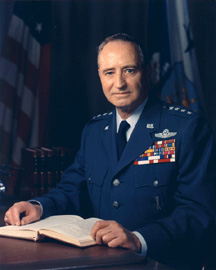
The de Havilland Canada DHC-4 Caribou is a Canadian specialized cargo aircraft with short takeoff and landing (STOL) capability. The Caribou was first flown in 1958 and although mainly retired from military operations, is still in use in small numbers as a rugged "bush" aircraft.
The title flight officer was a military rank used by the United States Army Air Forces during World War II, and also an air force rank in several Commonwealth countries, where it was used for female officers and was equivalent to the rank of flight lieutenant. The term flight officer is sometimes used today to describe job title positions as aircrew members.

Ronald Robert Fogleman is a retired United States Air Force general who served as the 15th Chief of Staff of the Air Force from 1994 to 1997 and as Commanding General of the United States Transportation Command from 1992 to 1994.
The Key West Agreement is the colloquial name for the policy paper Functions of the Armed Forces and the Joint Chiefs of Staff drafted by James V. Forrestal, the first United States Secretary of Defense. Its most prominent feature was an outline for the division of air assets between the Army, Navy, and the newly created Air Force which, with modifications, continues to provide the basis for the division of these assets in the U.S. military today.

The 23rd Flying Training Squadron is a unit of the United States Air Force, currently assigned to 58th Operations Group performing helicopter training at Fort Novosel, Alabama.
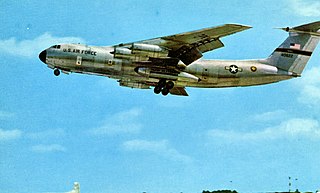
The Military Airlift Command (MAC) is an inactive United States Air Force major command (MAJCOM) that was headquartered at Scott Air Force Base, Illinois. Established on 1 January 1966, MAC was the primary strategic airlift organization of the Air Force until 1974, when Air Force tactical airlift units in the Tactical Air Command (TAC) were merged into MAC to create a unified airlift organization.

The 374th Airlift Wing is a unit of the United States Air Force assigned to Fifth Air Force. It is stationed at Yokota Air Base, Japan. It is part of Pacific Air Forces. The 374th Airlift Wing is the only airlift wing in PACAF and provides airlift support to all Department of Defense agencies in the Pacific theater of operation. It also provides transport for people and equipment throughout the Kantō Plain and the Tokyo metropolitan area.
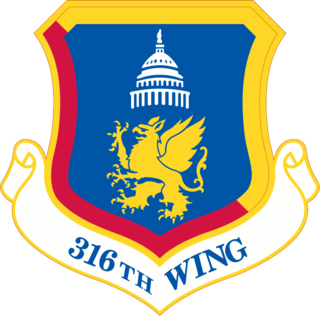
The 316th Wing is an active wing of the United States Air Force. It is the host wing at Joint Base Andrews Naval Air Facility, Maryland. As host wing, the 316 WG operates, administers and maintains the base. The 316th Wing was activated on June 11, 2020, becoming the host wing for JBA and taking on the Airmen and units of the 11th Wing.

The United States Army Aviation Branch is the administrative organization within the United States Army responsible for doctrine, manning and configuration for all army aviation units.
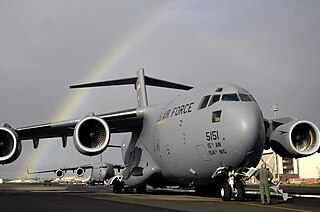
The 535th Airlift Squadron is part of the 15th Wing at Joint Base Pearl Harbor–Hickam, Hawaii. It operates C-17 Globemaster III aircraft providing airlift in the Pacific theater.

The 517th Airlift Squadron is an active unit of the United States Air Force, Pacific Air Forces 3d Wing at Joint Base Elmendorf–Richardson, Alaska. It operates Beechcraft C-12 Huron and Boeing C-17 Globemaster III aircraft providing airlift in the Pacific theater.

The 309th Airlift Squadron is an inactive United States Air Force unit, last based at Chièvres Air Base, Belgium and assigned to the 86th Airlift Wing at Ramstein Air Base, Germany. It operated a single C-37 aircraft providing executive airlift for NATO.

The 310th Special Operations Squadron is an active United States Air Force unit, based at Cannon Air Force Base, New Mexico. It was most recently activated in 2021 as part of the 27th Special Operations Group, flying the U-28A for Air Force Special Operations Command.

The 834th Airlift Division is an inactive United States Air Force organization. Its last assignment was with Military Airlift Command, assigned to Twenty-Second Air Force at Hickam Air Force Base, Hawaii, where it was inactivated on 1 April 1992.
The Pace-Finletter MOU of 1952 was a memorandum of understanding (MOU) signed on 4 November 1952 between Secretary of the Air Force Thomas K. Finletter and Secretary of the Army Frank Pace that removed the weight restrictions on helicopters that the United States Army could use. It also widened the range of tasks the Army's helicopters could be used for. However, it also created an arbitrary 5,000 pound weight restriction limit on the Army's ability to fly fixed-wing aircraft. As a result, the U.S. Army today is dependent upon the United States Air Force to purchase and man fixed-wing ground-attack aircraft to fulfill close air support missions.
"...that established a fixed wing weight limit of five thousand pounds empty, but weight restrictions on helicopters were eliminated ..."

The 537th Airlift Squadron is an inactive squadron of the United States Air Force. The unit was last active at Joint Base Elmendorf-Richardson Alaska, where it was inactivated on 13 September 2013.
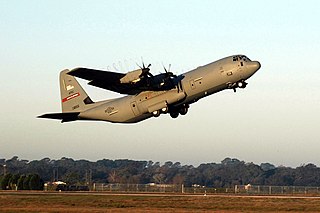
The 345th Airlift Squadron is an inactive United States Air Force squadron most recently assigned to the 19th Operations Group at Keesler Air Force Base, Mississippi, where it was inactivated in June 2014. The squadron was activated in the summer of 2010 as an "active duty associate" squadron, jointly operating the Lockheed C-130J Hercules aircraft of the 815th Airlift Squadron.

The 346th Tactical Airlift Squadron is an inactive United States Air Force squadron that was last assigned to the 314th Tactical Airlift Wing at Ching Chuan Kang Air Base, Republic of China, where it was inactivated in May 1971.
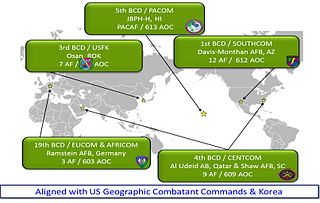
The Battlefield Coordination Detachment (US Army), or BCD, is the senior United States Army liaison element of the Army Air Ground System. The BCD serves as a bridge between the senior US Army headquarters element and the senior Air Force headquarters in each respective US combatant command or theater of operations. The BCD enables the coordination of Army-Air Force mission command, fire support, integrated air and missile defense, intelligence sharing, airspace management, and airlift. Additional space, cyber, and electronic warfare augmentation allow the BCD to further enable the designated Army force commander across the complete spectrum of warfare.

Vung Tau Air Base (1955–1975) was a Republic of Vietnam Air Force (RVNAF) facility. It was located near the city of Vũng Tàu in southern Vietnam. The United States used it as a base during the Vietnam War (1959–1975), stationing Army, Air Force and Navy units there. It was also the main base supporting Australian operations in the war and Australian Army and Royal Australian Air Force units were based there. Following the Fall of Saigon it reverted to a civil airport which remains in use today.
